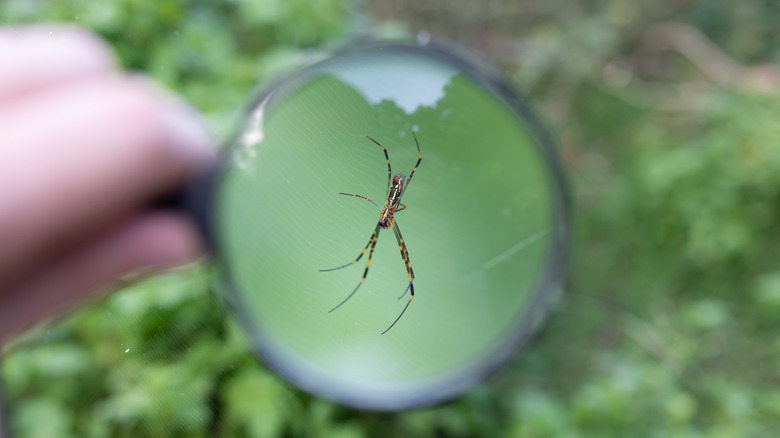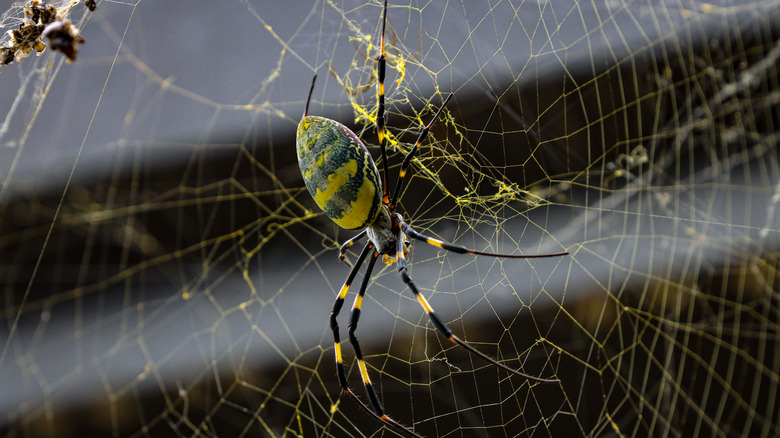The Creepy Crawly You Don't Want In Your Garden (And How To Keep It Out)
We may receive a commission on purchases made from links.
Most people aren't thrilled to suddenly walk into a spider web outdoors, especially large ones that are at approximately eye level. Now imagine you're in Georgia and you've had the misfortune of walking into a huge web stretched between your pecan trees. The responsible party has a 4-inch leg span and a caution-tape color scheme! Depending on your location, it's possible you've encountered the invasive Joro spider (Trichonephila clavata).
While venomous, they aren't particularly threatening to humans — they're quite shy, and at worst, a bite will probably feel like a bee sting. Their main threat is to the native ecosystem as they are able to outcompete native spiders with their expansive webs. Not to mention, most people probably don't want extremely sticky 10- to 20-foot webs all over their yard and garden! Fortunately, with some careful identification and (less fortunately) manual removal, you can probably keep a backyard population in check. To prevent them from moving in, make sure your garden stays clean, remove old piles, keep outdoor lights off when not in use, and consider insect screens to protect specific areas.
Hailing originally from east Asia, the Joro spider was first observed in northeast Georgia in 2014. As of autumn 2025, however, these introduced arachnids from the orb-weaving classification of spiders have also been observed in Tennessee, Alabama, North Carolina, South Carolina, Mississippi, and even as far as Oklahoma. They seem to be slowly yet steadily marching on the entire East Coast. Their spread seems almost guaranteed, as cold weather isn't a dealbreaker for these arachnids. Joro spiders are adaptable to environments ranging from cold northern Japan to steamy, tropical regions further south.
Identifying, reporting, and removing Joro spiders
If you already have Joro spiders, try to identify them correctly first. The large and flamboyant adult females are easiest to spot, with their black-and-yellow legs and inch-long yellow abdomens flaunting blue-green back stripes and red belly markings. Their webs are generally gold-colored. Males are difficult to spot, as they are only a ¼-inch long and mostly brown with some yellowish and brown striping. Make sure you aren't confusing the females in particular with similar-looking native species such as the golden-silk orb weaver (T. clavipes); one surefire way to tell these two apart is by the golden-silk orb weaver's patches of tufty black leg hair.
If you think you've definitely identified Joro spiders, photograph them if you can and file a report with Joro Watch, a website that, in partnership with the University of Georgia, tracks the progression of the Joro spider invasion. Once you've documented them, you can tackle the task of removing them. Unfortunately, destroying the webs or relocating the spiders is not enough, as they will return and rebuild.
The best way to kill these spiders if they're already there is to use a rake, stick, or some other long object to wrap them up in their own webs and then stomp on them. If you can't bear to do so manually — understandable! — certain aerosolized pest control products, including pet-safe Zevo Ant, Roach and Spider spray, are effective. (So is calling in a professional pest control company.) In addition to removing spiders from high-traffic areas, make sure you remove ones near areas where they might catch their food, such as pollinator gardens and beehives.

